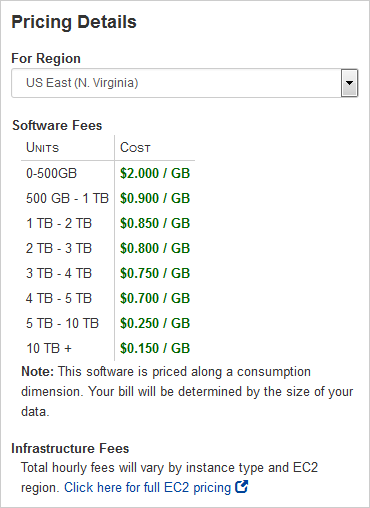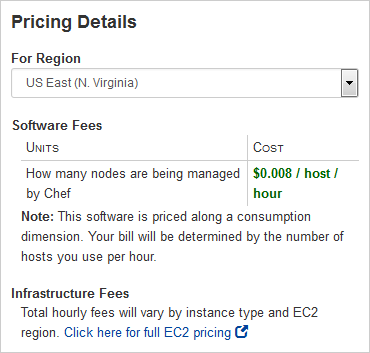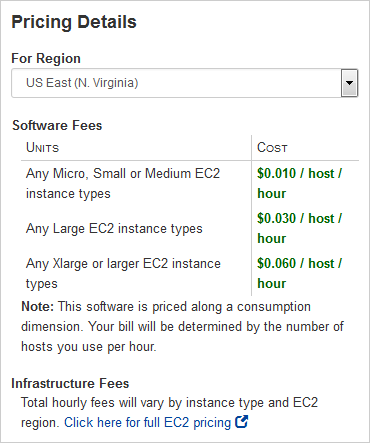Category: AWS Marketplace
New – Product Support Connection for AWS Marketplace Customers
There are now over 2,700 software products listed in AWS Marketplace. Tens of thousands of AWS customers routinely find, buy, and start using offerings from more than 925 Independent Software Vendors (ISVs).
Today we are giving you, as a consumer of software through AWS Marketplace, the ability to selectively share your contact information (name, title, phone number, email address, location, and organization) with software vendors in order to simplify and streamline your requests for product support. The vendors can programmatically access this information and store it within their own support systems so that they can easily verify your identity and provide you with better support.
This is an opt-in program. Sellers can choose to participate, and you can choose to share your contact information.
Product Support Connection as a Buyer
In order to test out this feature I launched Barracuda Web Application Firewall (WAF). After selecting my options and clicking on the Accept Software Terms & Launch with 1-click button, I was given the option to share my contact details:
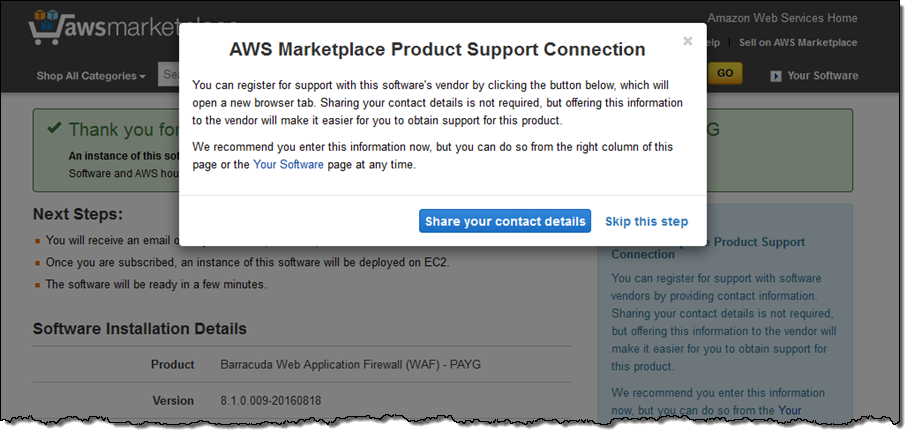
Then I entered my name and other information:
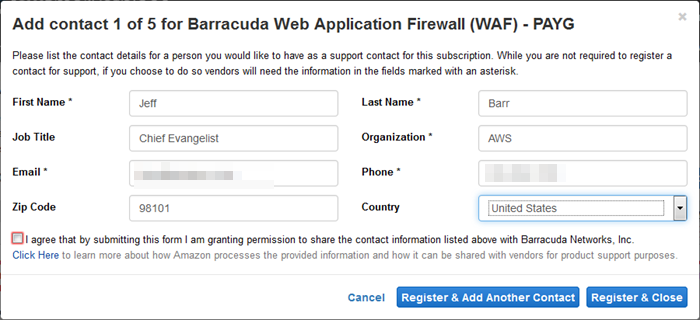
I have the option to enter up to 5 contacts for each subscription at this point. I can also add, change, or delete them later if necessary:
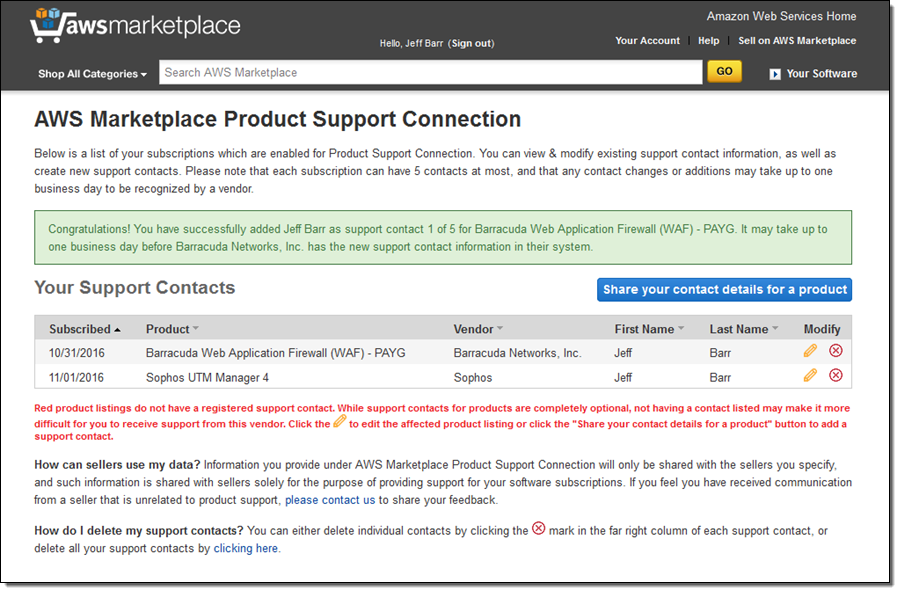
If products that I already own are now enabled for Product Support Connection, I can add contact details here as well.
Product Support Connection as a Seller
If I am an ISV and want to participate in this program, I contact the AWS Marketplace Seller & Catalog Operations Team (aws-marketplace-seller-ops@amazon.com). The team will enroll me in the program and provide me with access to a secure API that I can use to access contact information. Per the terms of the program, I must register each contact in my support or CRM system within one business day, and use it only for support purposes. To learn more, read AWS Marketplace Product Support Connection Helps Software Vendors Provide More Seamless Product Support on the AWS Partner Network Blog.
Getting Started
When I am searching for products in AWS Marketplace, I can select Product Support Connection as a desired product attribute:
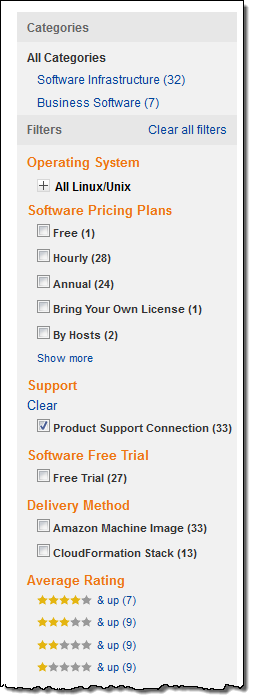
As part of today’s launch, I would like to thank the following vendors who worked with us to shape this program and to add the Product Support Connection to their offerings:
- Barracuda – Web Application Firewall (WAF), NextGen Firewall F-Series, Load Balancer ADC, Email Security Gateway, Message Archiver.
- Chef – Chef Server, Chef Compliance.
- Matillion – Matillion ETL for Redshift.
- Rogue Wave – OpenLogic Enhanced Support for CentOS (6 & 7, Standard & Security Hardened).
- SoftNAS – SoftNAS Cloud (Standard & Express).
- Sophos -Sophos UTM Manager 4, Sophos UTM 9.
- zData – Greenplum database.
- Zend – PHP, Zend Server.
- Zoomdata – Zoomdata.
We’re looking forward to working with other vendors who would like to follow their lead!
To get started, contact the AWS Marketplace Seller & Catalog Operations Team at aws-marketplace-seller-ops@amazon.com.
— Jeff;
AWS Solution – Transit VPC
Today I would like to tell you about a new AWS Solution. This one is cool because of what it does and how it works! Like the AWS Quick Starts, this one was built by AWS Solutions Architects and incorporates best practices for security and high availability.
The new Transit VPC Solution shows you how to implement a very useful networking construct that we call a transit VPC. You can use this to connect multiple Virtual Private Clouds (VPCs) that might be geographically disparate and/or running in separate AWS accounts, to a common VPC that serves as a global network transit center. This network topology simplifies network management and minimizes the number of connections that you need to set up and manage. Even better, it is implemented virtually and does not require any physical network gear or a physical presence in a colocation transit hub. Here’s what this looks like:
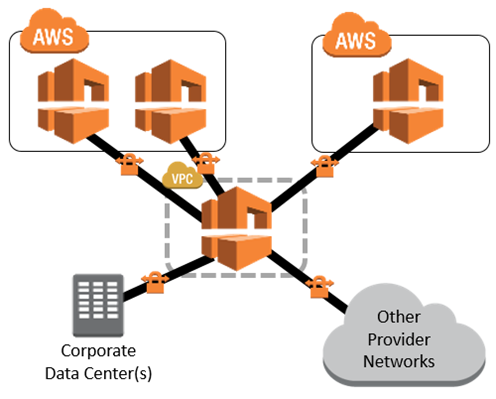
In this diagram, the transit VPC is central, surrounded by additional “spoke” VPCs, corporate data centers, and other networks.
The transit VPC supports several important use cases:
- Private Networking – You can build a private network that spans two or more AWS Regions.
- Shared Connectivity – Multiple VPCs can share connections to data centers, partner networks, and other clouds.
- Cross-Account AWS Usage – The VPCs and the AWS resources within them can reside in multiple AWS accounts.
The solution uses a AWS CloudFormation stack to launch and configure all of the AWS resources. It provides you with three throughput options ranging from 500 Mbps to 2 Gbps, each implemented over a pair of connections for high availability. The stack makes use of the Cisco Cloud Services Router (CSR), which is now available in AWS Marketplace. You can use your existing CSR licenses (the BYOL model) or you can pay for your CSR usage on an hourly basis. The cost to run a transit VPC is based on the throughput option and licensing model that you choose, and ranges from $0.21 to $8.40 per hour, with an additional cost (for AWS resources) of $0.10 per hour for each spoke VPC. There’s an additional cost of $1 per month for a AWS Key Management Service (KMS) customer master key that is specific to the solution. All of these prices are exclusive of network transit costs.
The template installs and uses a pair of AWS Lambda functions in a creative way!
The VGW Poller function runs every minute. It scans all of the AWS Regions in the account, looking for appropriately tagged Virtual Private Gateways in spoke VPCs that do not have a VPN connection. When it finds one, it creates (if necessary) the corresponding customer gateway and the VPN connections to the CSR, and then saves the information in an S3 bucket.
The Cisco Configurator function is triggered by the Put event on the bucket. It parses the VPN connection information and generates the necessary config files, then pushes them to the CSR instances using SSH. This allows the VPN tunnels to come up and (via the magic of BGP), neighbor relationships will be established with the spoke VPCs.
By using Lambda in this way, new spoke VPCs can be brought online quickly without the overhead of keeping an underutilized EC2 instance up and running.
The solution’s implementation guide, as always, contains step-by-step directions and security recommendations.
— Jeff;
PS – Check out additional network best practice guidance to find answers to common network questions!
AWS Marketplace Update – Support for ISVs Based in the EU
AWS Marketplace allows AWS customers to find, buy, and immediately start using cloud-based applications developed by Independent Software Vendors (ISVs). AWS customers collectively rack up 205 million hours per month of AWS Marketplace usage as they make use of over 2,700 offerings from over 925 ISVs.
Support for EU-Based ISVs
ISVs based in the European Union can now register their products in AWS Marketplace without having to create a US-based entity.
The following EU-based ISVs have already listed their products:
BI/Database
- EXASOL AG – EXASOL Analytic Database
- Data Virtuality GmbH – datavirtuality
- Quasardb – quasardb XTP
HPC/Storage
- ThinkParQ GmbH – BeeGFS
- Alces Flight Ltd – Alces Flight Compute
- ABSTRIUM / Pydio – Pydio Enterprise
Security/Monitoring
- Hyperglance – Hyperglance
- MikroTik – Cloud Hosted Router
- PerunWorks – Zenected Threat Defense VPN
Media/Communications
- Cinegy GmbH – Cinegy Air Pro
- Tikal Technologies – elasticRTC
Business Apps
- Fenix Engineering Solutions – nanoAPPs OCS Odoo v8 Spanish Pymes Edition
- Arcusys – Valamis
- Idu Software – idu-Concept
To learn more about their offerings, check our our new Software Solutions from European ISVs page!
Come on In
If you are a US or EU-based ISV and would like to list and sell your products in AWS Marketplace, visit our Sell on AWS Marketplace page.
— Jeff;
PS – Other recent feature additions to AWS Marketplace include Support for Clusters and AWS Resources and Additional Pricing Options for Sellers. Also, AWS customers can now request multi-year subscriptions to select products in AWS Marketplace at a negotiated discount from the software vendor (discounts on multi-year subscriptions vary by product and vendor). For more information on the eligible products and vendors, please contact us at aws-mp-bd@amazon.com.
New in AWS Marketplace – Enterprise Data Management/Protection from Ionic Security
In the last couple of months I have spoken with several Independent Software Vendors (ISVs) about their AWS Marketplace offerings. I’ve heard some impressive success stories and am working to share as many of them as possible.
Last week I spoke with the founders of Ionic Security to learn more about their product and new AWS Marketplace offering (AWS is an equity partner in Ionic). The platform was designed to meet the demanding needs of large-scale customers that operate in regulated industries. It helps them to understand how their data is being used and what actions are going to be performed on the data.
Using the theme of Data Management as a Service, the platform supports a common set of protocols that are accessible via web, desktop, and mobile applications.
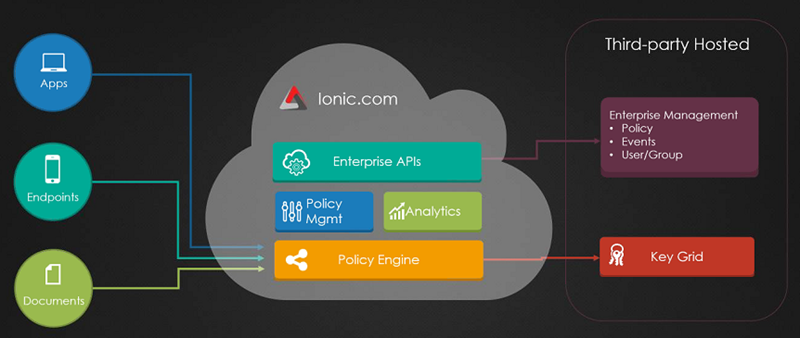
Ionic provides a distributed data protection and control environment that allows customers to protect and manage data on a very fine-grained basis, down to individual fields in a document. Each data element is assigned a unique, 64-bit KeyID via a running instance of the Ionic Key Server. Keys can be protected by AWS CloudHSM or by an on-premises Hardware Security Module. In either case, the HSM is responsible for protecting the encryption keys.
Developers use the Ionic SDK to build Ionic-enabled applications. SDK functions support device detection / fingerprinting, key management, encryption & decryption, and logging. The applications make use of an attribute-based policy engine that makes rapid go/no-go decisions when an application wants to access or update a data element. Support for more than 100 document management, productivity, and collaboration applications is already available.
The Ionic Dashboard is the mission control center for the product. It displays all interaction with the data, with multiple forms of visualization, filtering, and drill-down.
Organizations can choose to store the keys and the logging data in several different locations. With today’s announcement, they can now store their data in the AWS region of their choice. The product launches with just a couple of clicks and is up and running within two minutes or so.
Ionic in Action
Here are a couple of screen shots of Ionic in action. The Data Policy Overview provides an overview of activity:
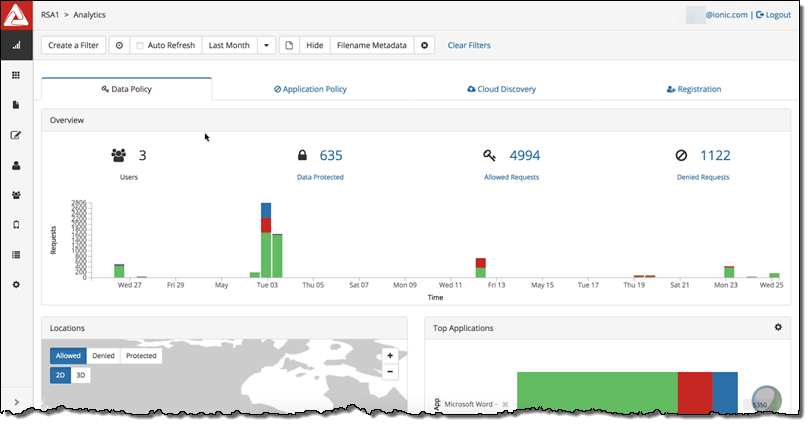
There’s also a geographic view:
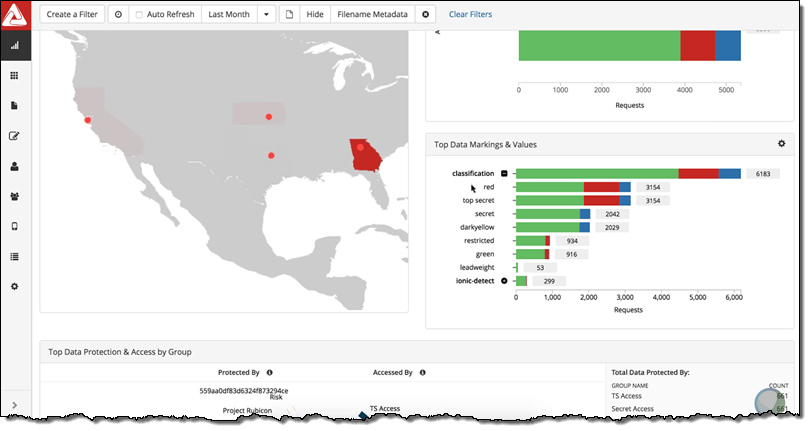
Detailed information is available for each data protection policy:
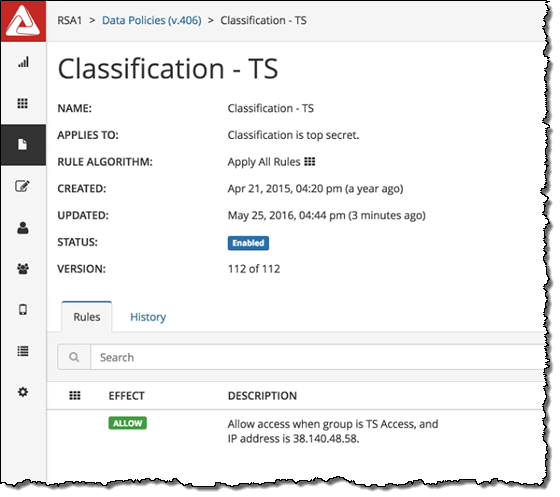
To get started, visit Ionic in AWS Marketplace. You may also want check out the Ionic resources page.
— Jeff;
New – AWS Marketplace for the U.S. Intelligence Community
 AWS built and now runs a private cloud for the United States Intelligence Community.
AWS built and now runs a private cloud for the United States Intelligence Community.
In order to better meet the needs of this unique community, we have set up an AWS Marketplace designed specifically for them. Much like the existing AWS Marketplace, this new marketplace makes it easy to discover, buy, and deploy software packages and applications, with a focus on products in the Big Data, Analyics, Cloud Transition Support, DevOps, Geospatial, Information Assurance, and Security categories.
Selling directly to the Intelligence Community can be a burdensome process that limits the Intelligence Community’s options when purchasing software. Our goal is to give the Intelligence Community as broad a selection of software as possible, so we are working to help our AWS Marketplace sellers through the onboarding process so that the Intelligence Community can benefit from use of their software.
If you are an Amazon Marketplace Seller and have products in one of the categories above, listing your product in the AWS Marketplace for the Intelligence Community has some important benefits to your ISV or Authorized Reseller business:
Access – You get to reach a new market that may not have been visible or accessible to you.
Efficiency – You get to bypass the contract negotiation that is otherwise a prerequisite to selling to the US government. With no contract negotiation to contend with, you’ll have less business overhead.
To the greatest extent possible, we hope to make the products in the AWS Marketplace also available in the AWS Marketplace for the U.S. Intelligence Community. In order to get there, we are going to need your help!
Come on Board
Completing the steps necessary to make products available in the AWS Marketplace for the U.S. Intelligence Community can be challenging due to security and implementation requirements. Fortunately, the AWS team is here to help; here are the important steps:
- Have your company and your products listed commercially in AWS Marketplace if they are not already there.
- File for FOCI (Foreign Ownership, Control and Influence) approval and sign the AWS Marketplace IC Marketplace Publisher Addendum.
- Ensure your product will work in the Commercial Cloud Services (C2S) environment. This includes ensuring that your software does not make any calls outside to the public internet.
- Work with AWS to publish your software on the AWS Marketplace for the U.S. Intelligence Community. You will be able to take advantage of your existing knowledge of AWS and your existing packaging tools and processes that you use to prepare each release of your product for use in AWS Marketplace.
Again, we are here to help! After completing step 1, email us (icmp@amazon.com). We’ll help with the paperwork and the security and do our best to get you going as quickly as possible. To learn more about this process, read my colleague Kate Miller’s new post, AWS Marketplace for the Intelligence Community, on the AWS Partner Network Blog.
— Jeff;
New in AWS Marketplace: Alces Flight – Effortless HPC on Demand
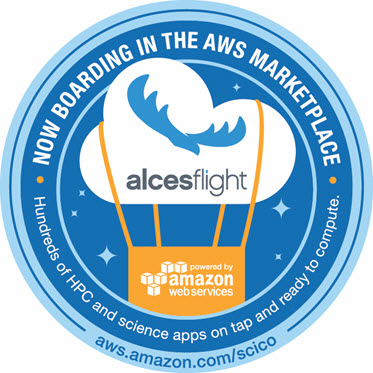 In the past couple of years, academic and corporate researchers have begun to see the value of the cloud. Faced with a need to run demanding jobs and to deliver meaningful results as quickly as possible while keeping costs under control, they are now using AWS to run a wide variety of compute-intensive, highly parallel workloads.
In the past couple of years, academic and corporate researchers have begun to see the value of the cloud. Faced with a need to run demanding jobs and to deliver meaningful results as quickly as possible while keeping costs under control, they are now using AWS to run a wide variety of compute-intensive, highly parallel workloads.
Instead of fighting for time on a cluster that must be shared with other researchers, they accelerate their work by launching clusters on demand, running their jobs, and then shutting the cluster down shortly thereafter, paying only for the resources that they consume. They replace tedious RFPs, procurement, hardware builds and acceptance testing with cloud resources that they can launch in minutes. As their needs grow, they can scale the existing cluster or launch a new one.
This self-serve, cloud-based approach favors science over servers and accelerates the pace of research and innovation. Access to shared, cloud-based resources can be granted to colleagues located on the same campus or halfway around the world, without having to worry about potential issues at organizational or network boundaries.
Alces Flight in AWS Marketplace
Today we are making Alces Flight available in AWS Marketplace. This is a fully-featured HPC environment that you can launch in a matter of minutes. It can make use of On-Demand or Spot Instances and comes complete with a job scheduler and hundreds of HPC applications that are all set up and ready to run. Some of the applications include built-in collaborative features such as shared graphical views. For example, here’s the Integrative Genomics Viewer (IGV):
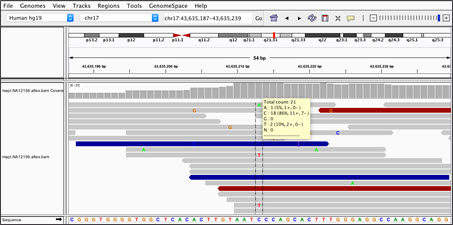
Each cluster is launched into a Virtual Private Cloud (VPC) with SSH and graphical desktop connectivity. Clusters can be of fixed size, or can be Auto Scaled in order to meet changes in demand. Once launched, the cluster looks and behaves just like a traditional Linux-powered HPC cluster, with shared NFS storage and passwordless SSH access to the compute nodes. It includes access to HPC applications, libraries, tools, and MPI suites.
We are launching Alces Flight in AWS Marketplace today. You can launch a small cluster (up to 8 nodes) for evaluation and testing or a larger cluster for research.
If you subscribe to the product, you can download the AWS CloudFormation template from the Alces site. This template powers all of the products, and is used to quickly launch all of the AWS resources needed to create the cluster.
EC2 Spot Instances give you access to spare AWS capacity at up to a 90% discount from On-Demand pricing and can significantly reduce your cost per core. You simply enter the maximum bid price that you are willing to pay for a single compute node; AWS will manage your bid, running the nodes when capacity is available at the desired price point.
Running Alces Flight
In order to get some first-hand experience with Alces Flight, I launched a cluster of my own. Here are the settings that I used:
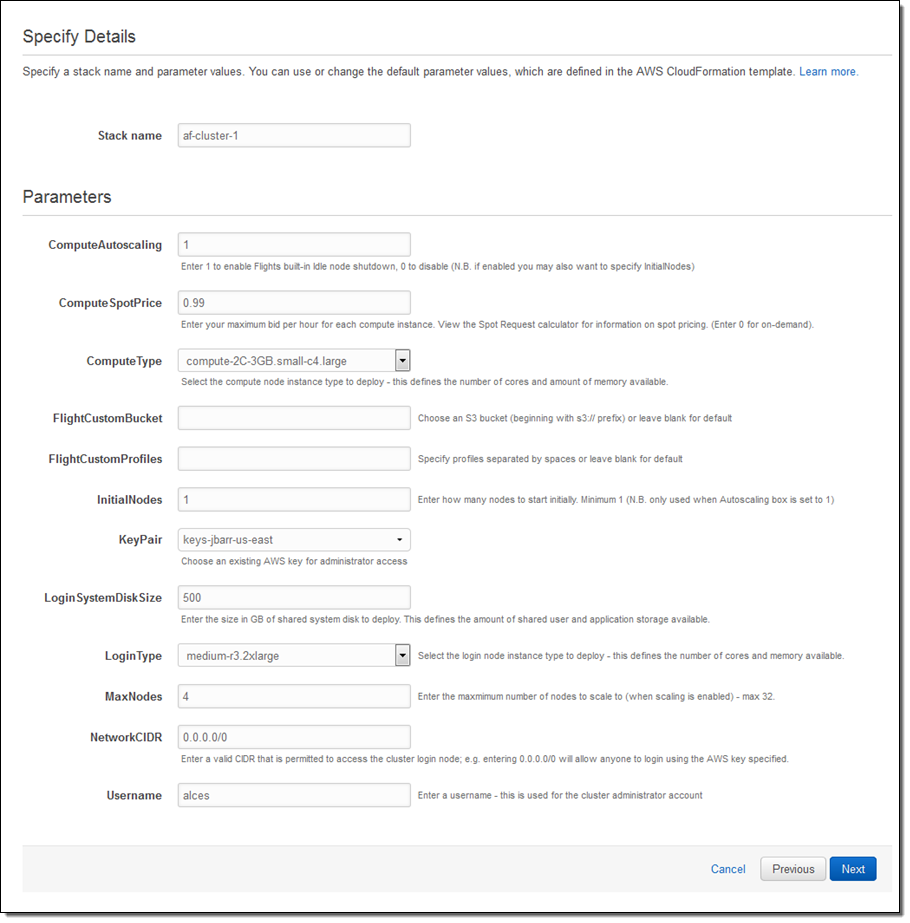
I set a tag for all of the resources in the stack as follows:

I confirmed my choices and gave CloudFormation the go-ahead to create my cluster. As expected, the cluster was all set up and ready to go within 5 minutes. Here are some of the events that were logged along the way:
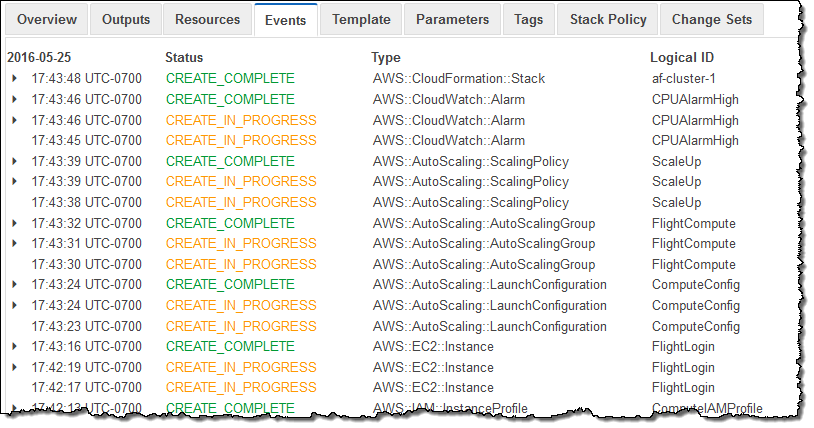
Then I SSH’ed in to the login node and saw the greeting, all as expected:
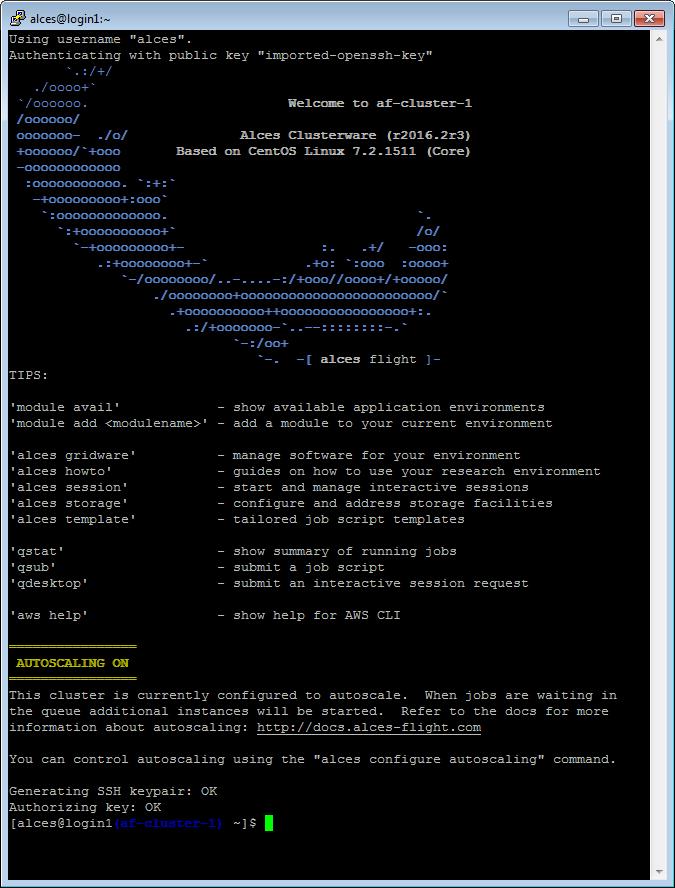
After I launched my cluster I realized that this post would be more interesting if I had more compute nodes in my cluster. Instead of starting over, I simply modified my CloudFormation stack to have 4 nodes instead of 1, applied the change, and watched as the new nodes came online. Since I specified the use of Spot Instances when I launched the cluster, Auto Scaling placed bids automatically. Once the nodes were online I was able to locate them from within my PuTTY session:
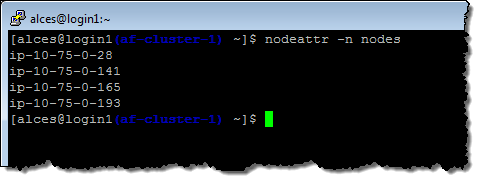
Then I used the pdsh (Parallel Distributed Shell command) to check on the up-time of each compute node:

Learn More
This barely counts as scratching the surface; read Getting Started as Quickly as Possible to learn a lot more about what you can do! You should also watch one or more of the Alces videos to see this cool new product in action.
If you are building and running data-intensive HPC applications on AWS, you may also be interested in another Marketplace offering. The BeeGFS (self-supported or support included) parallel file system runs across multiple EC2 instances, aggregating the processing power into a single namespace, with all data stored on EBS volumes. The self-supported product is also available on a 14 day free trial. You can create a cluster file system using BeeGFS and then use it as part of your Alces cluster.
— Jeff;
Additional Pricing Options for AWS Marketplace Products
 Forward-looking ISVs (Indepdendent Software Vendors) are making great use of AWS Marketplace. Users can find, buy, and start using products in minutes, without having to procure hardware or install any software. This streamlined delivery method can help ISVs to discover new customers while also decreasing the length of the sales cycle. The user pays for the products via their existing AWS account, per the regular AWS billing cycle.
Forward-looking ISVs (Indepdendent Software Vendors) are making great use of AWS Marketplace. Users can find, buy, and start using products in minutes, without having to procure hardware or install any software. This streamlined delivery method can help ISVs to discover new customers while also decreasing the length of the sales cycle. The user pays for the products via their existing AWS account, per the regular AWS billing cycle.
As part of the on-boarding process for AWS Marketplace, each ISV has the freedom to determine the price of the software. The ISV can elect to offer prices for monthly and/or annual usage, generally with a discount. For software that is traditionally licensed on something other than time, ISVs make multiple entries in AWS Marketplace, representing licensing options on their chosen dimension.
This model has worked out well for many types of applications. However, as usual, there’s room to do even better!
More Pricing Options
ISVs have told us that they would like to have some more flexibility when it comes to packaging and pricing their software and we are happy to oblige. Some of them would like to extend the per-seat model without having to create multiple entries. Others would like to charge on other dimensions. A vendor of security products might want to charge by the number of hosts that were scanned. Or, a vendor of analytic products might want to charge based on the amount of data processed.
In order to accommodate all of these options, ISVs can now track and report on usage based on a pricing dimension that makes sense for their product (number of hosts scanned, amount of data processed, and so forth). They can also establish a per-unit price for this usage ($0.50 per host, $0.25 per GB of data, and so forth). Charges for this usage will appear on the user’s AWS bill.
I believe that this change will open the door to an even wider variety of products in the AWS Marketplace.
Implementing New Pricing Options
If you are an ISV and would like to use this new model price to your AWS Marketplace products, you need to add a little bit of code to your app. You simply measure usage along the appropriate dimension(s) and then call a new AWS API function to report on the usage. You must send this data (also known as a metering record) once per hour, even if there’s no usage for the hour. AWS Marketplace expects each running copy of the application to generate a metering record each hour in order to confirm that the application is still functioning properly. If the application stops sending records, AWS will email the customer and ask them to adjust their network configuration.
Here’s a sample call to the new MeterUsage function:
AWSMarketplaceMetering::MeterUsage("4w1vgsrkqdkypbz43g7qkk4uz","2015-05-19T07:31:23Z", "HostsScanned", 2);
The parameters are as follows:
- AWS Marketplace product code.
- Timestamp (UTC), in ISO-8601 format.
- Usage dimension.
- Usage quantity.
The usage data will be made available to you as part of the daily and monthly seller reports.
Some Examples
Here are a couple of examples of products that are already making use of this new pricing option. As you can see in the Infrastructure Fees, these vendors have chosen to price their products along a variety of interesting (and relevant) dimensions:
Available Now
This new pricing option is available now and you can start using it today!
— Jeff;
AWS Marketplace Adds SharePoint Enterprise
AWS Marketplace makes it simple for you to discover, buy, and deploy many different types of software packages and applications including Network Infrastructure, Security, Web Apps, Business Intelligence, Big Data, DevOps, Media, and Storage / Backup.
Access to SharePoint Enterprise
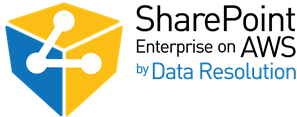 I am happy to be able to announce that SharePoint Enterprise is now available to purchase and deploy in AWS Marketplace. Designed to suit the needs of many different types and sizes of organizations up to and including multinational enterprises, SharePoint Enterprise supports custom applications, mobile applications, social media integration, business intelligence, and advanced content management (none of which is available in the entry-level SharePoint Foundation product).
I am happy to be able to announce that SharePoint Enterprise is now available to purchase and deploy in AWS Marketplace. Designed to suit the needs of many different types and sizes of organizations up to and including multinational enterprises, SharePoint Enterprise supports custom applications, mobile applications, social media integration, business intelligence, and advanced content management (none of which is available in the entry-level SharePoint Foundation product).
This new offering helps customers to migrate their SharePoint and Windows Server workload and is made possible by the folks at Data Resolution. As a long-time SharePoint provider and Microsoft Hosting Provider, they have the background and experience needed to design and support a scalable implementation of SharePoint Enterprise in the AWS Cloud. They are already migrating one of their on-premises SharePoint customers to AWS, and are planning to work with us to produce a customer success story later this year. Data Resolution will also be offering consulting and migration services in order to make your transition to the cloud as smooth as possible.
As you will see when you launch SharePoint on your own, this implementation makes use of our new AWS Marketplace Support for Clusters and AWS Resources. The sophistication and size of the AWS implementation varies according to the product type. For example, the SharePoint Enterprise 2013 Advanced option includes single-server deployments of Active Directory 2012 and SQL Server 2012, along with a load-balanced pair of instances running Windows Server 2012.
Multiple Options
We have worked with Data Resolution to make sure that you have several different options when you choose to run SharePoint Enterprise on AWS (all of the options include phone, email, and forum support from Data Resolution):
- Product Type – You can choose SharePoint Enterprise 2013 Basic, SharePoint Enterprise 2013 Business, or SharePoint Enterprise 2013 Advanced.
- Pricing Model – You can start with a free trial, pay by the hour, by the month, or annually. If you choose the annual option, the pricing reflects a 10% discount.
- User Count – You can choose between 10, 25, and 100 user options (in this context, a user refers to someone who adds, deletes, or changes content stored in SharePoint).
- License Type – If you already have licenses for SharePoint Enterprise 2013 Business or SharePoint Enterprise 2013 Advanced, you can make use of them as part of this offering. You can also choose an option that includes the cost of the applicable license.
- AWS Region – You can run SharePoint Enterprise in the US East (Northern Virginia), US West (Oregon), or US West (Northern California) Regions.
These options give you a lot of flexibility! You can run a small deployment of SharePoint Enterprise 2013 Basic on an hourly basis for development and testing, or to meet the needs of a short-term project or event. Or, you can run a larger deployment of SharePoint Enterprise 2013 Advanced on a permanent basis. Either way, you can choose to run in one of three US locations. All of these options will allow you to address and accommodate success and growth in usage without undue hassles.
Getting Started
You can get started at no charge by launching the free trial of SharePoint Enterprise 2013 for AWS Basic “All in One.” This offering was designed for test and development teams working on short-term projects.
— Jeff;
AWS Marketplace – Support for the Asia Pacific (Seoul) Region
Early in my career I worked for several companies that developed and shipped (on actual tapes) packaged software. Back in those pre-Internet days, marketing, sales, and distribution were all done on a country-by-country basis. This often involved setting up a field office and hiring local staff, both of which were expensive, time-consuming, and somewhat speculative. Providing prospective customers with time-limited access to trial copies was also difficult for many reasons including hardware and software compatibility, procurement & licensing challenges, and all of the issues that would inevitably arise during installation and configuration.
Today, the situation is a lot different. Marketing, sales, and distribution are all a lot simpler and more efficient, thanks to the Internet. For example, AWS Marketplace has streamlined the procurement process. With ready access to a very wide variety of commercial and open source software products from ISVs, customers can find what they want, buy it, and deploy it to AWS in minutes, with just a few clicks. Because many of the products in AWS Marketplace include a free trial and/or an hourly pricing option, potential large-scale users can take the products for a spin and make sure that they will satisfy their needs.
Support for the Asia Pacific (Seoul) Region
Now that the new Asia Pacific (Seoul) Region is up and running, customers located in Korea, as well as global companies serving Korean end users, can take advantage of the AWS Marketplace. There are now more than 600 products available for 1-click deploy in categories such as Network Infrastructure, Security, Storage, and Business Intelligence.
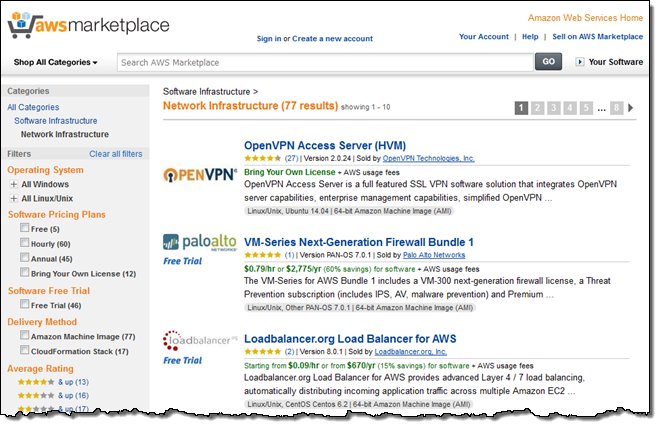
These products are available under several different pricing plans including free, hourly, monthly, and annual. For companies that already own applicable licenses for the desired products, a BYOL (Bring Your Own License) option is also available.
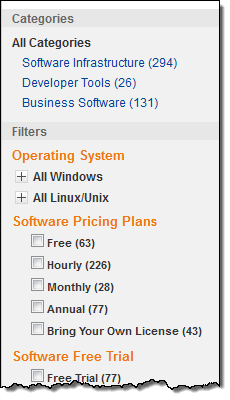
As I write this, more than 150 products are available for free trials in the Asia Pacific (Seoul) Region!
Several Korean ISVs have already listed their products on AWS Marketplace. Here’s a sampling:
- TMAXSoft – Tibero5 (paid AMI).
- Gruter – Enterprise Tajo (paid AMI).
- PentaSecurity – CloudBric (SaaS).
ISV Opportunities
If you are a software vendor or developer and would like to list your products in AWS Marketplace, please take a look at the Sell on AWS Marketplace information. Customers will be able to launch your products in minutes and pay for it as part of the regular AWS billing system. As a vendor of products that are available in AWS Marketplace, you will be able to discover new customers and benefit from a shorter sales cycle.
— Jeff;
New – AWS Marketplace Support for Clusters and AWS Resources
AWS Marketplace is an online store that helps you to find, buy, and immediately start using a very wide variety of applications on AWS (some of the more popular categories are Network Infrastructure, Security, and Big Data).
Up until now, running an application from AWS Marketplace was essentially equivalent to launching a single, self-contained Amazon EC2 instance. This was a good starting point, but it was not sufficient to deal with more sophisticated applications that run across a cluster of instances and/or require additional AWS resources such as Auto Scaling groups, Elastic Load Balancers, SQL database instances, an advanced network configuration, message queues, and so forth.
Support for Clusters and AWS Resources
To address this customer need, an application in the AWS Marketplace can now be represented by up to three AWS CloudFormation templates, each created by the application vendor, and each with a distinct set of deployment options. Before you actually launch a template-backed product, you will see a list of the AWS resources that will be created, along with an estimate of the monthly costs. Vendors also have the option to provide the traditional AMI-powered option alongside the new and more powerful template-powered options.
Initial Application Support
We have been working with a group of application vendors to make their applications available in this new and more flexible fashion. Here’s what you can launch today:
- Sophos –Sophos UTM 9 Autoscaling.
- Tibco – Jaspersoft for AWS with Multi-Tenancy (Hourly).
- NetApp – OnCommand Cloud Manager on Linux.
- MapR – Enterprise Database Edition Plus.
We’ll be adding more applications in the very near future.
As you can see from this screen shot, the deployment options are clearly visible, as is the estimated cost:
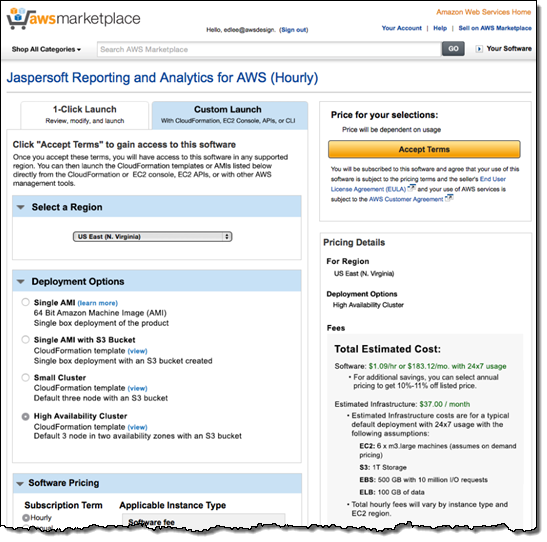
Template Power!
Because this new option makes use of CloudFormation, sophisticated users have access to some interesting new features. The launch process makes use of the CloudFormation console and supports the usual prompting for parameters and generation of multiple output values. Templates can be downloaded, inspected, and even edited in the CloudFormation Designer that we launched earlier this year.
Note to Application Vendors
If you are already selling your products on the Marketplace and would like to take advantage of this new option, contact your AWS BDM (Business Development Manager) or email the AWS Marketplace team at aws-marketplace-seller-ops@amazon.com. If you are new to AWS Marketplace, start by reading our Sell on Marketplace page.
— Jeff;

